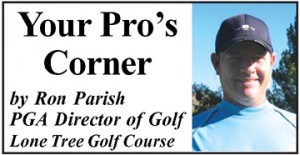Play the Percentages
Course management tips to help your scoring
How often do you go out on the course and you have your “A” game?  If you play several times a week you probably have your best game more frequently then the once or twice a month player. But even the frequent golfer, has their “A” game 20-30% of the time? 40% at most? Golf has so many different facets so it is tough to get them all going at once. But often, golfers manage their game as if they were playing with their “A” game always and because of this, they run into trouble. I would suggest some of the following course management tips that offer “higher percentages” for successful shots and thereby help keep you away from trouble and higher numbers.
If you play several times a week you probably have your best game more frequently then the once or twice a month player. But even the frequent golfer, has their “A” game 20-30% of the time? 40% at most? Golf has so many different facets so it is tough to get them all going at once. But often, golfers manage their game as if they were playing with their “A” game always and because of this, they run into trouble. I would suggest some of the following course management tips that offer “higher percentages” for successful shots and thereby help keep you away from trouble and higher numbers.
-
Play your strike zone. Be familiar with your shot pattern and where you tend to miss. When you have you’re “A” game the ball goes where you want it to, but when you don’t there is generally a common miss you need to recognize and play for. When you hit your driver do you fade or draw? Think in terms of a baseball pitcher. If his pitches generally curve left to right, he is aiming at the left side of the plate and the ball moves into the strike zone. If your tee shot moves the same way, you should tee up on the right side of the tee box and aim at the left rough edge, thereby letting your tee shot curve towards the fairway target. Players with right to left curve conversely tee up on the left side of the tee box, aim at the right edge of rough and let the ball curve back towards the fairway target. This way, you have given yourself the entire width of the fairway to work with and doubled the size of your target area compared to aiming straight down the middle.
-
Take enough club when hitting into greens. The next time you are out, look at where all the trouble is when you hitting your approach shots. The sand traps are generally in front of the green, or a water hazard, or a grass bunker. Often the greens are elevated so even though the player is at the 150 yard marker the elevated green requires an extra 5-10 yards of carry. You may hit a #8 iron 150 yards with your “A” game, but with the trouble in front and your “B” or “C” swing being around 70% of the time or more, hit the #7 iron (more club), get enough carry and stay out of the trouble.
-
Forget the pin and aim for the fat. Also when approaching the greens, notice where the “fat” part of the green is. Usually this is the center of the green. Play a round and forget about going after the pins and aim for the fat of the green and the center. Chances are, with this in mind, your are going to hit more greens in your round which will help your scoring. This tip was one that the great Ben Hogan often kept in mind.
-
When chipping, keep the ball on the ground as much as possible. Often times, when a player misses the green the chip that you face is on fairway mown grass and still doesn’t have to carry over rough but more fairway or fringe. In this situation, use the Texas wedge (putter), a hybrid or fairway metal, or your #7 iron and make a firm putting motion and keep the ball rolling along the ground. When you have your “A” game, you feel like you can wedge it perfect, but when you are a little off with the wedge, you can get a fat “short” or thin “long” and you are chipping once again and the score is going up. You’ll find this running shot is never “chunky”. With a little bit of practice and imagination you will gain confidence and this shot which will keep double bogeys or worse at bay.
-
When putting, think speed not line. Players who over focus on line often get the speed wrong and leave themselves a tough second putt. With “A” game taking the day off, really just focus on trying to get the speed of your first putt right so that you leave the ball by the hole for a tap in. Imagine a big hula hoop around the cup and try and lag your 1st putt into it. This way you aren’t trying to be too aggressive and ram the ball in, but also you are thinking in terms of enough acceleration to get the ball to the hole so you get the ball there. Many higher handicappers’ 3- putts occur from hitting the first putt too soft.
On the days your game is just a little bit off, try these course management tips. You should find more favorable percentages for success with your shots and scores that become more consistent. Email any questions that you have to RonParish@lonetreegolfcourse.com. To learn more about golf at Lone Tree, visit www.LoneTreeGolfCourse.com.
the attachments to this post:





















